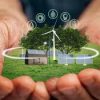Green and Clean Technology
Green and Clean Technology
Introduction
In a rapidly changing world where environmental degradation is becoming a serious concern, green and clean technology has emerged as a powerful solution to combat climate change, reduce pollution, and ensure a healthier planet for future generations. These technologies focus on sustainable methods of production, energy consumption, waste management, and transportation that minimize the negative impact on the environment.
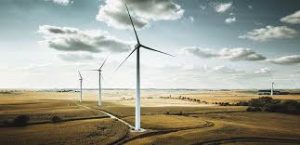
What is Green and Clean Technology?
Green and clean technology refers to innovations and practices that promote environmental sustainability and energy efficiency. These technologies are designed to use fewer natural resources, produce less waste, and emit lower levels of greenhouse gases. The main goal is to create a balance between technological advancement and ecological preservation.
Key Features of Green and Clean Technology
-
Energy Efficiency: Reducing energy use through efficient appliances, smart grids, and low-energy lighting systems like LED.
-
Renewable Energy: Utilizing natural energy sources such as solar, wind, hydro, and geothermal instead of fossil fuels.
-
Pollution Reduction: Technologies that reduce emissions from vehicles, factories, and power plants.
-
Waste Management: Recycling, composting, and waste-to-energy solutions to reduce landfill use.
-
Sustainable Agriculture: Using techniques like organic farming, drip irrigation, and bio-fertilizers.
-
Eco-Friendly Materials: Creating products from biodegradable, recycled, or non-toxic materials.
Examples of Green and Clean Technologies
-
Solar panels – Convert sunlight into electricity with zero emissions.
-
Electric vehicles – Reduce dependence on fossil fuels and cut down on air pollution.
-
Wind turbines – Harness wind energy to produce clean power.
-
Green buildings – Constructed using energy-efficient systems and sustainable materials.
-
Smart thermostats – Regulate heating and cooling systems to save energy.
Benefits of Green and Clean Technology
-
Environmental Protection: Reduces carbon emissions, conserves natural resources, and protects ecosystems.
-
Economic Growth: Creates new job opportunities in the green sector, including renewable energy and waste management.
-
Health Improvements: Less air and water pollution leads to fewer health issues among populations.
-
Energy Independence: Countries can reduce dependence on imported fuels by investing in local renewable sources.
-
Cost Savings: In the long run, green technologies often save money through lower energy and maintenance costs.
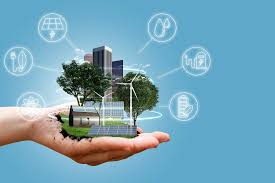
Challenges
Despite its potential, the adoption of green and clean technology faces challenges such as:
-
High initial costs of installation.
-
Lack of awareness and education.
-
Resistance from industries relying on traditional methods.
-
Limited government policies or incentives in some regions.
The Future of Green and Clean Technology:
The future of Green and clean technology looks promising as governments, industries, and individuals increasingly recognize the importance of environmental sustainability. Innovations in artificial intelligence, nanotechnology, and biotechnology are expected to further revolutionize green tech solutions. International cooperation, stronger policies, and investment in research will be key to accelerating the transition to a greener future.
✅ Why Solar Panels Are Green Technology:
-
Renewable Energy Source: They harness sunlight, which is abundant and free.
-
Zero Emissions: They generate electricity without producing carbon dioxide or other greenhouse gases.
-
Energy Efficiency: Reduces dependence on fossil fuels like coal and oil.
-
Low Maintenance: Once installed, they require minimal upkeep and last for decades.
Other examples include:
-
Wind turbines
-
Electric vehicles (EVs)
-
LED lighting
-
Rainwater harvesting systems
-
Biodegradable packaging
Clean Tech vs Green Tech: What’s the Difference?
Although Green and clean technology and green technology are often used interchangeably, there is a subtle difference between the two:
✅ Clean Technology (Clean Tech)
Definition:
Clean tech focuses on reducing or eliminating pollution and waste during the production or use of goods and services.
Key Purpose:
To make existing processes and energy sources cleaner and more efficient.
Examples:
-
Carbon capture and storage
-
Water purification systems
-
Air filtration technologies
-
Electric vehicles
-
Energy-efficient appliances
Focus Area:
Primarily on reducing environmental damage caused by traditional industries.
✅ Green Technology (Green Tech)
Definition:
Green tech goes a step further by focusing on sustainability and environmental protection through the use of renewable resources.
Key Purpose:
To create Eco-friendly alternatives and promote long-term environmental sustainability.
Examples:
-
Solar panels
-
Wind turbines
-
Organic farming technologies
-
Biodegradable materials
-
Sustainable building design
Focus Area:
On preserving natural resources and preventing environmental harm from the beginning.
🟩 In Summary:
| Feature | Clean Tech | Green Tech |
|---|---|---|
| Goal | Reduce pollution & waste | Promote sustainability & Eco-solutions |
| Approach | Improve existing methods | Create new Eco-friendly alternatives |
| Examples | water filters, carbon capture | Solar power, wind energy, organic farming |
| Energy Focus | Cleaner use of any energy | Use of renewable energy only |
The 3 R’s of Green Technology are:
♻️ Reduce, Reuse, Recycle
These principles help minimize waste, conserve natural resources, and protect the environment.
1. Reduce
-
Meaning: Use fewer resources by cutting down on consumption and waste.
-
Example: Using energy-efficient appliances, turning off lights when not in use, or printing less paper.
2. Reuse
-
Meaning: Use items multiple times instead of throwing them away.
-
Example: Reusing shopping bags, water bottles, or donating old clothes and electronics.
3. Recycle
-
Meaning: Convert waste materials into new products to prevent waste and reduce the need for raw materials.
-
Example: Recycling paper, plastic, glass, and metal.
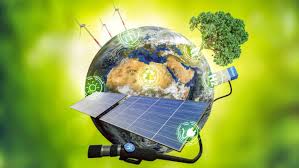
🌍 Why They Matter in Green Technology:
These 3 R’s support green technology by:
-
Reducing pollution and landfill waste.
-
Lowering energy usage and greenhouse gas emissions.
-
Promoting sustainable manufacturing and consumption.
⚡ What is Clean Green Power?
Clean Green Power refers to electricity generated from renewable, non-polluting, and eco-friendly sources that do not harm the environment or deplete natural resources.
✅ Key Features of Green and clean technology Power:
-
No Pollution – Does not emit harmful gases like CO₂ or toxic waste.
-
Renewable – Comes from sources that naturally replenish (like sun, wind, and water).
-
Sustainable – Safe for long-term use without damaging the Earth.
🌱 Examples of Green and clan technology Power Sources:
-
☀️ Solar Power – Energy from sunlight using solar panels.
-
🌬️ Wind Power – Electricity from wind using turbines.
-
🌊 Hydro power – Energy from flowing water (dams or rivers).
-
🌋 Geothermal Energy – Heat energy from beneath the Earth.
-
🌾 Biomass – Energy from organic materials like plants and waste.
⚙️ Why It Matters:
-
Reduces dependence on fossil fuels (coal, oil, gas).
-
Helps fight climate change by lowering carbon emissions.
-
Promotes energy security and a cleaner environment.
🌍 The 7 Main Sources of Renewable Energy:
Renewable energy sources are natural, constantly replenished, and environmentally friendly. Here are the 7 major types:
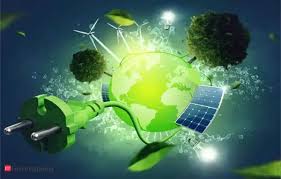
1. ☀️ Solar Energy
-
Source: Sunlight
-
How it works: Solar panels convert sunlight into electricity or heat.
-
Common uses: Home electricity, water heaters, solar farms.
2. 🌬️ Wind Energy
-
Source: Moving air (wind)
-
How it works: Wind turbines convert wind’s kinetic energy into electricity.
-
Common uses: Wind farms, rural electricity supply.
3. 🌊 Hydro power (Hydroelectric Energy)
-
Source: Flowing water (rivers, dams)
-
How it works: Water turns turbines to generate electricity.
-
Common uses: Large-scale electricity production.
4. 🌾 Biomass Energy
-
Source: Organic material (plants, wood, waste)
-
How it works: Burning or processing organic matter to produce heat or fuel.
-
Common uses: Cooking fuel, electricity, bio-fuels like ethanol.
5. 🌋 Geothermal Energy
-
Source: Heat from beneath the Earth’s surface
-
How it works: Steam or hot water from underground used to drive turbines.
-
Common uses: Power generation, heating buildings.
6. 🌊 Tidal Energy
-
Source: Movement of ocean tides
-
How it works: Turbines are driven by rising and falling tides.
-
Common uses: Coastal electricity generation (limited locations).
7. 🌊 Wave Energy
-
Source: Surface waves in the ocean
-
How it works: Devices on the water’s surface convert wave motion into energy.
-
Common uses: Experimental and small-scale power generation.
🌱 What Are Green and clean technology Energy Technologies?
Green and clean technology energy technologies are innovations that generate power or support energy use without harming the environment. They rely on renewable, clean, and sustainable resources, helping reduce pollution, conserve natural resources, and combat climate change.
✅ List of Major Green and clean technology Energy Technologies:
1. ☀️ Solar Power Technology
-
Example: Photovoltaic (PV) panels, solar water heaters.
-
How it works: Converts sunlight into electricity or heat.
-
Use: Homes, industries, street lighting.
2. 🌬️ Wind Energy Technology
-
Example: Wind turbines (onshore & offshore).
-
How it works: Uses wind to spin turbines that generate electricity.
-
Use: Wind farms for urban and rural power supply.
🌊 Hydro power Technology
-
Example: Dams, run-of-the-river systems.
-
How it works: Uses flowing water to turn turbines and produce electricity.
-
Use: Large-scale power plants and micro-hydro systems.
4. 🌾 Biomass Technology
-
Example: Bio-gas plants, biomass stoves, bio-fuel processing.
-
How it works: Converts organic waste into heat, gas, or liquid fuel.
-
Use: Cooking, heating, electricity, transportation fuel.
5. 🌋 Geothermal Energy Technology
-
Example: Geothermal heat pumps, steam turbines.
-
How it works: Taps heat from beneath the Earth’s surface.
-
Use: Space heating, electricity generation.
6. 🌊 Tidal and Wave Energy Technology
-
Example: Tidal barrages, underwater turbines, oscillating water columns.
-
How it works: Uses ocean tides and waves to generate power.
-
Use: Coastal energy systems (emerging technology).
7. 🏠 Green Building Technology
-
Example: Energy-efficient lighting, solar rooftops, natural ventilation.
-
How it works: Combines design and systems to reduce energy consumption.
-
Use: Eco-friendly homes, offices, and factories.
8. 🔋 Energy Storage and Smart Grid
-
Example: Lithium-ion batteries, pumped hydro storage, smart meters.
-
How it works: Stores renewable energy and distributes it efficiently.
-
Use: Balances supply and demand, ensures clean energy availability.
🌎 Why Green Energy Technologies Matter:
-
Cut down greenhouse gas emissions
-
Reduce dependence on fossil fuels
-
Create green jobs and Eco-friendly innovation
-
Protect ecosystems and public health

